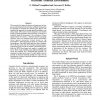Free Online Productivity Tools
i2Speak
i2Symbol
i2OCR
iTex2Img
iWeb2Print
iWeb2Shot
i2Type
iPdf2Split
iPdf2Merge
i2Bopomofo
i2Arabic
i2Style
i2Image
i2PDF
iLatex2Rtf
Sci2ools
FLAIRS
2004
2004
Agent-based Players for a First-person Entertainment-based Real-time Artificial Environment
The necessity for improved players and opponents in firstperson entertainment-based real-time artificial environments has inspired our research into artificial game players. We employed the approach of creating agent-based players, one using simple reflex-action based components and another based on a back propagation neural network, to interact in a modified Quake II environment. Our evaluation of these agents utilizes two metrics, a statistical measure and graph similarity based on clustering from player performance traces against interactive feature points in the environments--both comparing the agents to a sample of 20 human players. The reflex-based agent was able to complete 29 of 100 test levels with 73.1% within statistical humanperformance levels and 15.4% similar to the human players, while the BPNN-based agent was unable to complete any levels. These results, including some additional findings that reveal the potential for a combinational approach, are inspiring an architec...
Artificial Game Players | Artificial Intelligence | FLAIRS 2004 | Human Players | Real-time Artificial Environments |
| Added | 30 Oct 2010 |
| Updated | 30 Oct 2010 |
| Type | Conference |
| Year | 2004 |
| Where | FLAIRS |
| Authors | G. Michael Youngblood, Lawrence B. Holder |
Comments (0)

